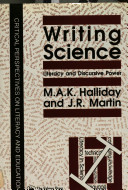
Unlike commonsense knowledge, which can tolerate — indeed, depends on — compromises, contradictions and indeterminacies of all kinds, scientific knowledge as it was then coming into being needed to be organized around systems of technical concepts arranged in strict hierarchies of kinds and parts. In the event, none of the artificial languages was ever used for the purpose; but the experience of linguistic design that went into creating them was drawn upon in subsequent work, for example in constructing systematic nomenclatures for use in botany and in vchemistry. Even where no special linguistic structures have been developed for the purpose, an essential feature of all scientific registers since that time has been their systems of technical terms.
But there is another aspect of scientific language that is just as important as its technical terminology, and that is its technical grammar. Interestingly, the seventeenth century language planners paid no attention to this. Wilkins’ philosophical language did, of course, incorporate a grammar — otherwise it would not have been a language, in any practical sense; but it was a grammar of a conventional kind, without any of the innovatory thinking that had gone into the lexical morphology. Yet if we examine how scientists such as Newton were actually using language in their own writings, we find innovations in the grammar which are no less striking than those embodied in the construction of technical terms. People are, of course, less conscious of grammar than they are of vocabulary; no doubt this is one reason for the discrepancy. …
But when we observe these two features, technical vocabulary and nominalized grammar, in a passage of scientific text … we can see that they are interdependent. Creating a technical term is itself a grammatical process; and when the argument is constructed by the grammar in this way, the words that are turned into nouns tend thereby to become technicalized. In other words, although we recognize two different phenomena taking place (as we must, in order to be able to understand them), in practice they are different aspects of a single semiotic process: that of evolving a technical form of discourse, at a particular ‘moment’ in socio-historical time. …
The language of science is, by its nature, a language in which theories are constructed; its special features are exactly those which make theoretical discourse possible. But this clearly means that the language is not passively reflecting some preexisting conceptual structure; on the contrary, it is actively engaged in bringing such structures into being. They are, in fact, structures of language; as Lemke has expressed it, ‘a scientific theory is a system of related meanings’. We have to abandon the naive ‘correspondence’ notion of language, and adopt a more constructivist approach to it. The language of science demonstrates rather convincingly how language does not simply correspond to, reflect or describe human experience; rather, it interprets or, as we prefer to say, ‘construes’ it. A scientific theory is a linguistic construal of experience.
But in that respect scientific language is merely foregrounding the constructive potential of language as a whole. The grammar of every natural language — its ordinary everyday vocabulary and grammatical structure — is already a theory of human experience. (It is also other things as well.) It transforms our experience into meaning. Whatever language we use, we construe with it both that which we experience as taking place ‘out there’, and that which we experience as taking place inside ourselves — and (the most problematic part) we construe them in a way which makes it possible to reconcile the two. …
It is not too fanciful to say that the language of science has reshaped our whole world view. But it has done so in ways which (as is typical of many historical processes) begin by freeing and enabling but end up by constraining and distorting. This might not matter so much if the language of science had remained the special prerogative of a priestly caste (such a thing can happen, when a form of a language becomes wholly ceremonial, and hence gets marginalized). In our recent history, however, what has been happening is just the opposite of this. A form of language that began as the semiotic underpinning for what was, in the worldwide context, a rather esoteric structure of knowledge has gradually been taking over as the dominant mode for interpreting human existence. Every text, from the discourses of technocracy and bureaucracy to the television magazine and the blurb on the back of the cereal packet, is in some way affected by the modes of meaning that evolved as the scaffolding for scientific knowledge.
Halliday, M.A.K. and Martin, J.R. 1993. Writing Science: Literacy and Discursive Power. Pittsburgh: University of Pittsburgh Press. pp. 4-6, 8-11. || Amazon || WorldCat
